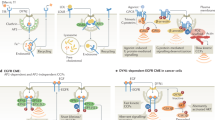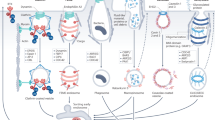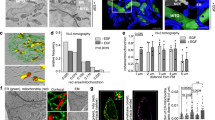Abstract
ABSTRACT: Receptor-mediated endocytosis (RME) provides one major pathway for the trafficking of extracellular molecules into the cell. This involves the binding of a ligand to a specific cell surface receptor, clustering of the ligand-receptor complexes in coated pits, invagination and pinching off of the coated pits to form coated vesicles, and delivery of coated vesicles to discrete membrane-limited cytoplasmic sorting organelles, endosomes. Within these endosomes, ligands and receptors are each targeted to their appropriate cellular destination (e.g., lysosome, cytoplasm, opposite cell surface). The cell and molecular biologic basis for such a tightly regulated process is now beginning to be understood and is reviewed herein.
Similar content being viewed by others
Log in or create a free account to read this content
Gain free access to this article, as well as selected content from this journal and more on nature.com
or
Author information
Authors and Affiliations
Rights and permissions
About this article
Cite this article
Schwartz, A. Receptor Cell Biology: Receptor-Mediated Endocytosis. Pediatr Res 38, 835–843 (1995). https://doi.org/10.1203/00006450-199512000-00003
Issue date:
DOI: https://doi.org/10.1203/00006450-199512000-00003
This article is cited by
-
Responses of the ciliates Tetrahymena and Paramecium to external ATP and GTP
Purinergic Signalling (2005)



